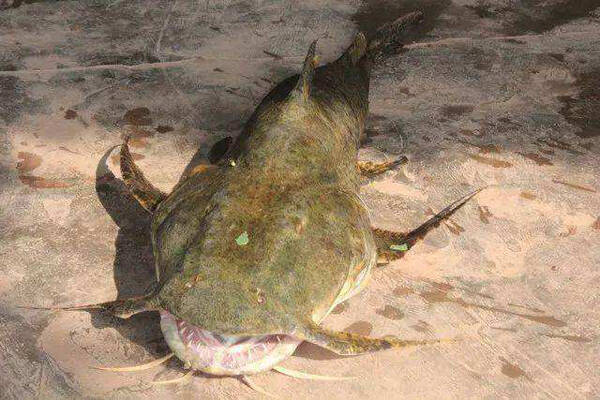The Latin name of the giant yarrelli is Bagarius yarrelli, which belongs to the order Siluriformes, family Scyphidae, and the genus Scyphus.

The food is mainly small fish. It is slow-moving and greedy, and can be caught with a dragnet or sinking hook. Individuals are large, weighing more than 50kg. The meat is yellow, and it is commonly known as the melon fish, which is probably derived from this. It is the main edible fish in the production area.
The giant catfish is a truly large fish, with a body length of up to 200 cm. They survive in turbulent rivers, relying on their own weight, strong and powerful bodies, and a body shape suitable for high-speed swimming. The skin of the giant catfish is brown chestnut, the body is streamlined, and the head is wide and slightly flat. And its head is very long, and it is roughly a long-waisted trapezoid when viewed from above. This shape with extremely prominent forward momentum shows its nature as a ferocious predator. The giant catfish is very easy to identify, its snout is convex, the upper lip covers the lower jaw, and especially the pair of whiskers around the mouth are different from ordinary catfish. Generally, people would say that the whiskers of catfish are "a beard" or something like that, but the base of the whiskers of the giant croaker is flat, and the texture is quite tough. It extends outward in a semi-arc, like two sickles extending from the edge of the lips. It is precisely this majestic head and whiskers that make it recognized as a brave and radical "hawk" figure in the catfish family, thus getting the name "Eagle Duckbill".
The pectoral and dorsal fins of the adult giant croaker are wide, and there are long floating fins. This strange fish with a strange appearance, a majestic aura, and a terrifying legend is a sought-after variety among collectors. Fortunately, its juvenile temperament is not too fierce, and it does not resist mixed breeding with fish of the same size. In other words, when the giant croaker is young, you can "save some space". In addition, it only needs neutral water quality and a water temperature of 22°C~26°C, and the acceptable range of fluctuation is relatively large, so it is considered to be a relatively easy-to-raise fish species.
The artificial breeding experiment was successful on March 24, 2012, and the artificial breeding experiment was carried out again on April 20, obtaining about 1,000 fry; the embryonic development process of the giant bream was observed and recorded. When the incubation water temperature is 27℃, the giant bream takes 20 hours to emerge from the membrane.
It is listed in the second level of the "List of National Key Protected Wildlife in China".
Protect wild animals and eliminate game.
Maintaining ecological balance is everyone's responsibility!